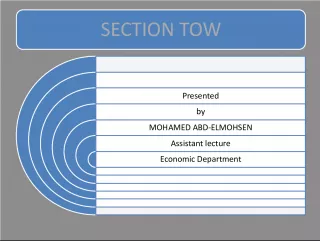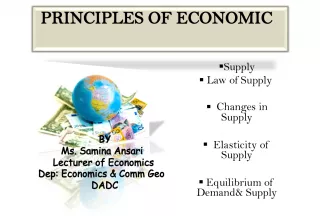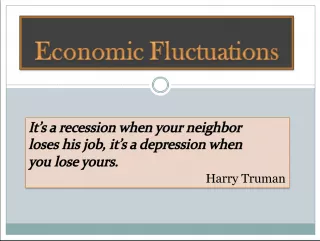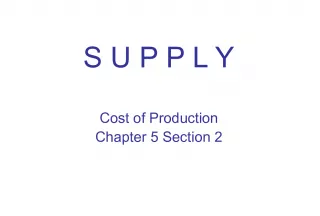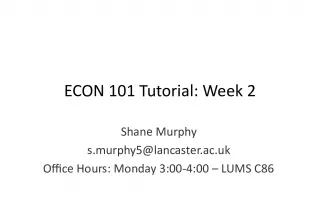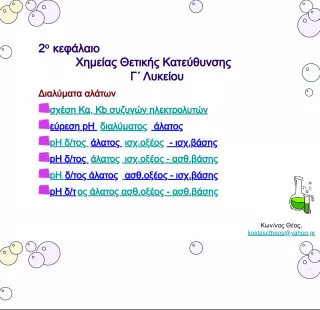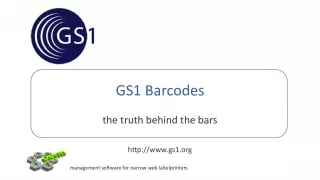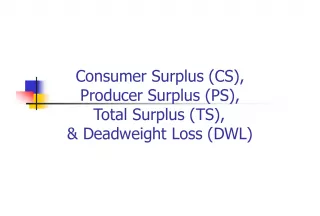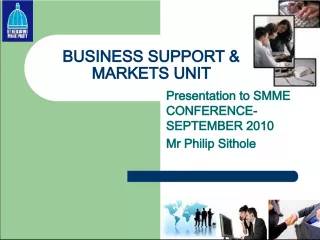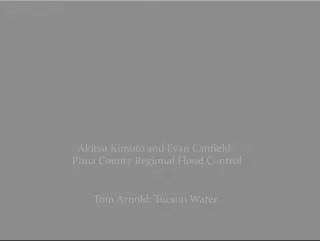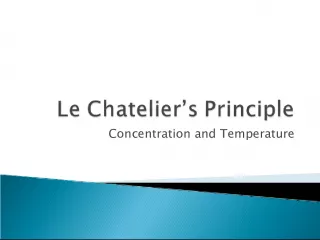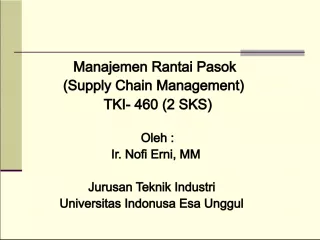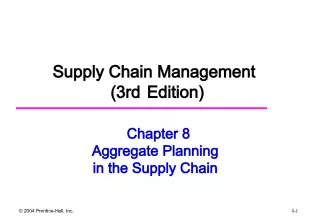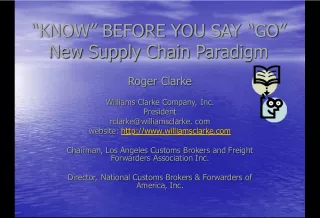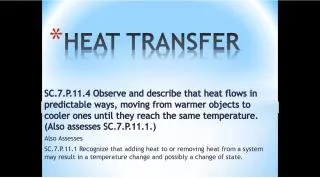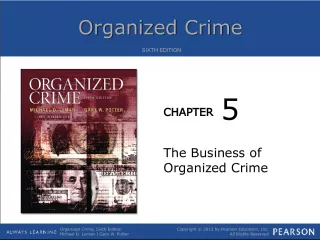Combining Demand and Supply to Reach Equilibrium
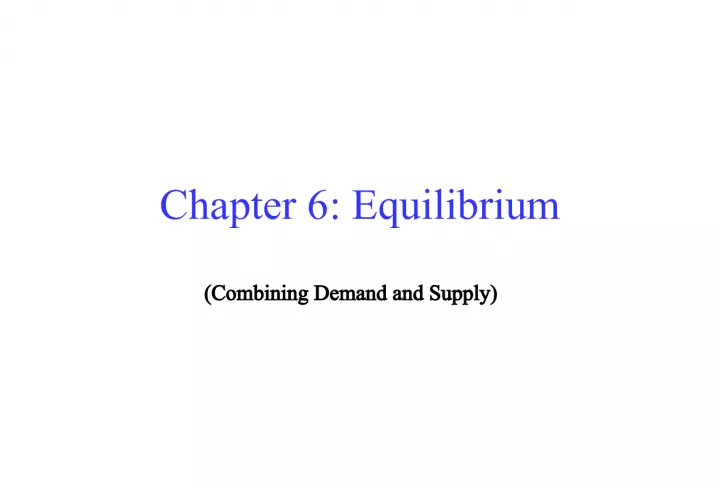

In Chapter 6, we explore the concept of equilibrium by bringing together the forces of demand and supply. We review the differences between demand and supply, where consumers are willing and able
- Uploaded on | 1 Views
-
 lisareyes
lisareyes
About Combining Demand and Supply to Reach Equilibrium
PowerPoint presentation about 'Combining Demand and Supply to Reach Equilibrium'. This presentation describes the topic on In Chapter 6, we explore the concept of equilibrium by bringing together the forces of demand and supply. We review the differences between demand and supply, where consumers are willing and able. The key topics included in this slideshow are . Download this presentation absolutely free.
Presentation Transcript
Slide1Chapter 6: Equilibrium(Combining Demand and Supply)
Slide2Review:Demand vs. Supply
Slide3Demand vs. Supply • Consumers are willing and able to purchase • Price and Quantity have an INVERSE relationship • Negative Slope • Curves Down and to Right • Businesses are willing and able to sell • Price and Quantity have a DIRECT relationship • Positive Slope • Curves Up and to Right
Slide4Movements:Movements: Demand vs. Supply • Cause: Price (Ceteris Paribus) • Called: Change in Quantity Demanded • Cause: Price (Ceteris Paribus) • Called: Change in Quantity Supplied
Slide5Shifts:Shifts: Demand vs. Supply • Cause: Quantity (PYNTE) • Called: Change in Demand • Cause: Quantity (SPENT) • Called: Change in Supply
Slide6Is this Demand or Supply ? 1. PYNTE variables • Demand 2. 3. • SUPPLY • Demand 4. Ceteris Paribus causes a movement • Demand and SUPPLY 5. 6. SPENT variables • SUPPLY • SUPPLY
Slide7Demand• Starting at point X 1. Increase in Quantity Demanded 2. Decrease in Quantity Demanded 3. Increase in Demand 4. Decrease in Demand Z Y S Y
Slide8Supply• Starting at point X 1. Increase in Quantity Supplied 2. Decrease in Quantity Supplied 3. Increase in Supply 4. Decrease in Supply Y Z S Q
Slide9How much are you going to payfor that doggie in the window? Answer: The market price .
Slide10Doggie Example“The price will settle at the point where the number of dogs for sale exactly matches the number of dogs that consumers want to buy. If there are more potential pet owners than dogs available, then the price of dogs will go up. Some consumers will then decide to buy ferrets instead and some pet shops will offer more dogs for sale. Eventually, the supply of dogs will match the demand. Remarkably, some markets actually work this way. --Naked Economics, p. 15
Slide11Equilibrium The point at which Demand and Supply are EQUAL at the SAME Price and Quantity Example: Point F
Slide12What is Equilibrium?Price Quantity Demanded Quantity Supplied $1 5 1 $2 4 2 $3 3 3 $4 2 4 $5 1 5
Slide13EquilibriumPrice Quantity Demanded Quantity Supplied $1 5 1 $2 4 2 $3 3 3 $4 2 4 $5 1 5
Slide14EquilibriumPrice Quantity Demanded Quantity Supplied $1 5 1 $2 4 2 $3 3 3 $4 2 4 $5 1 5
Slide15What is the difference between…Equilibrium Price The Price at which Quantity Demanded and Quantity Supplied are EQUAL Example: $3 Equilibrium Quantity The Quantity at which Quantity Demanded and Quantity Supplied are EQUAL Example: 3
Slide16Equilibrium PriceExample: $2 Equilibrium Quantity Example: 20
Slide17Disequilibrium Any Price or Quantity NOT at equilibrium Demand and Supply are NOT equal in the Market Example: Points Y and X
Slide187. Identifya) Equilibrium price has [increased / decreased] b) Equilibrium quantity has [increased / decreased]
Slide197. Identifya) Equilibrium price has [increased / decreased] b) Equilibrium quantity has [increased / decreased]
Slide20Outcomes of Disequilibrium… Excess Demand Excess Supply
Slide21Excess Demand Quantity Demanded is MORE than Quantity Supplied AKA: Shortage
Slide22Excess Demand (Shortage) 1 2 3 4 5 6 Scenario: Betty wants 10 Candy Bars. The problem is that there is only 6 on the shelves 1 2 3 4 5 6 7 8 9 10 The Green represents TOO much DEMAND The Purple Represents NOT enough Supply
Slide23Excess Demand (Shortage)Real-Life Examples: • Turkeys before Thanksgiving • Elmo dolls before Christmas • Eggs before Easter • Flu shots during flu season • California’s electricity shortage
Slide24Excess Demand(Shortage) • What do you think will eventually happen to PRICE when there is a shortage?
Slide25Excess Demand(Shortage) • What do you think will eventually happen to PRICE when there is a shortage? • It will INCREASE
Slide26Excess Supply Quantity Demanded is LESS than Quantity Supplied AKA: Surplus
Slide27Excess Supply (Surplus) The Green represents NOT enough Demand The Purple Represents TOO much Supply Scenario: Betty went to the mall for 2 t-shirts. The store had 8 t-shirts. 1 2 3 4 5 6 7 8 1 2
Slide28Excess Supply (Surplus) Real-Life Examples: • Christmas decorations after the Christmas • Crops are in season—like apples in the fall or watermelon in the summer • Companies thought a product would sell— but no one wants it
Slide29Excess Supply (Surplus) • What do you think will eventually happen to PRICE when there is a surplus?
Slide30Excess Supply (Surplus) • What do you think will eventually happen to PRICE when there is a surplus? • It will DECREASE
Slide31Why would adeer cost $43,000?
Slide32Why would a deer cost$43,000? There are local farms that breed deer for the purpose of selling them— “deer farms” These deer farms grow deer for the sole purpose of selling them —mostly to people in Western states.
Slide33Why would a deer cost$43,000? The buyers purchase deer to: • Increase the amount of deer in Western woods (where hunters pay a certain amount of money each year to hunt in a particular area) • For genetics—to reproduce and create “more superior” deer
Slide34Why would a deer cost$43,000? • When there is NOT a lot of genetically superior deer, the supply for deer decreases. • Because many people want the deer, the number of demanders increases. • As a result, the price of deer increases—to $43,000!!!
Slide35Why would a deer cost$43,000? Answer: Excess Demand (shortage)
Slide36Outcomes of Price Control… Price Ceiling Price Floor
Slide37Price Ceiling The MAXIMUM Price that can be legally charged for a good or service Example: Rent Control Advantages: Keeps prices lower & affordable Disadvantages: Reduces Quantity and Quality
Slide38Price Floor The MINIMUM Price that can be legally charged for a good or service Example: Minimum wage Advantage: Creates a standard Disadvantage: More unemployed because costs increase
Slide39Black MarketItems sold illegally Examples: Babies, guns, drugs
Slide40Efficient Resource AllocationDistribute goods and services adequately
Slide41Role of Prices
Slide42PricesAdvantages 1. Measure of value 2. Signal of how and what to produce 3. Flexibility 4. Costs nothing to administer 5. Wide choice of goods 6. Efficiency Disadvantages 1. People use the black market 2. Can cause shortages or surpluses 3. Can cause externalities (unintended economic side effects) 4. Consumers make ill- advised decisions
Slide43Which ones do they have in common?P: Price of Related Goods Y: Income N: Number of Demanders T: Taste E: Expectations S: Supplier Input Costs P: Price of Related Good E: Expectations N: Number of Suppliers T: Technology, Taxes, Tampering, Temperature Causes in Change in Demand Causes in Change in Supply
Slide44Also…The “N” variables are different— Demand: Demand: N: Number of Demanders Supply: Supply: N: Number of Suppliers The “T” variables are different— Demand: Demand: T: Taste Supply: Supply: T: There are 4 of them… none of which are TASTE!!!
Slide45Bails of HayThe price of hay is expected to increase. (From $4 a bail now to $ 10 a bail in the future) Is there a PYNTE variable? Is there a SPENT variable?
Slide46Bails of HayThe price of hay is expected to increase. (From $4 a bail now to $ 10 a bail in the future) Is there a PYNTE variable? YES Is there a SPENT variable? YES What is the variable?
Slide47Bails of HayThe price of hay is expected to increase. (From $4 a bail now to $ 10 a bail in the future) What is the Variable? Expectations What happens to the demand of bails of hay? What happens to the supply of bails of hay?
Slide48Bails of HayThe price of hay is expected to increase. (From $4 a bail now to $ 10 a bail in the future) Expectations The demand for bails of hay INCREASES The supply for bails of hay DECREASES Which direction does the demand curve and supply curve shift? Demand Now Demand Later Supply Now Supply Later P I P I Q I Q D Q D Q I
Slide49Bails of HayThe price of hay is expected to increase. (From $4 a bail now to $ 10 a bail in the future) Expectations The demand for bails of hay INCREASES The supply for bails of hay DECREASES The demand curve shifts to the RIGHT The supply curve shifts to the LEFT What happens to the equilibrium price of the bail of hay?
Slide50Bails of HayThe price of hay is expected to increase. (From $4 a bail now to $ 10 a bail in the future) Expectations The demand for bails of hay INCREASES The supply for bails of hay DECREASES The demand curve shifts to the RIGHT The supply curve shifts to the LEFT The equilibrium price of the bail of hay will INCREASE .
Slide51 Wooden Desks The price of wood increases. Is there a PYNTE variable? Is there a SPENT variable?
Slide52 Wooden Desks The price of wood increases. Is there a PYNTE variable? NO Is there a SPENT variable? YES What is the SPENT variable?
Slide53 Wooden Desks The price of wood increases. What is the SPENT variable it? S (supplier input costs) What happens to the supply of wooden desks?
Slide54 Wooden Desks The price of wood increases. S (supplier input costs) What happens to the supply of wooden desks? DECREASES Which direction does the supply curve shift?
Slide55 Wooden Desks The price of wood increases. S (supplier input costs) Supply of wooden desks DECREASES The supply curve shifts to the LEFT What happens to the equilibrium price and equilibrium quantity of the desks?
Slide56 Wooden Desks The price of wood increases. S (supplier input costs) Supply of wooden desks DECREASES The supply curve shifts to the LEFT The Equilibrium price (INCREASES) Equilibrium quantity (DECREASES)
Slide57 • “Help! Help! Here come the Bears” --Hair Bear Bunch Equilibrium Song
Slide58Equilibrium Song• Figure out Demand, put it on the graph… bum, bum, bum • Figure out Supply, put it on the graph… bum, bum, bum
Slide59Standards• 6.2.12EF • 6.3.12DEF • 6.4.12DE • 6.5.12ABDF
